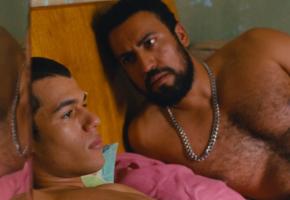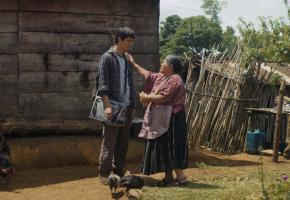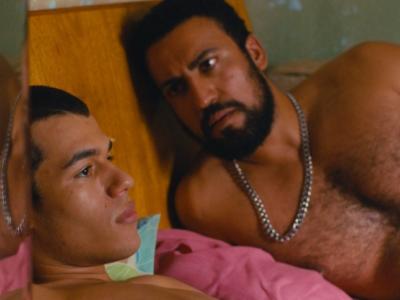Spirits, birds and omens are symbols that are not usually associated with the ‘gangster’ genre, but in ‘Birds of Passage’, all these elements fuse as the traditional world of the Wayuu people clashes with the harsh modernity brought about by their own and the ‘alijuna’s’ (outsider’s) greed and corruption. No one was entirely innocent in this scheme of things.
The germ of this narrative began to grow when Ciro Guerra and Cristina Gallego were filming another production in the north of Colombia: -
“We heard many stories that people would tell us about how they had been involved in the Bonanza Marimbera, (that is now clearly seen as illegal - this period, from the 1960 – 1980s saw the massive cultivation and trade of high-quality marijuana in the areas of La Guajira, César and Magdalena]....we were particularly impressed by the stories of how it had all begun, the initial links and the subsequent bonanza. They [the Wayuu tribe] spoke of an innocent time, naïve even, describing it as their ‘Golden Days’. That was almost shocking and it made us interested in finding out what it was about that beginning that made it so very different to what we see today and the way that that phenomenon has been stigmatized. We realized we wanted to delve deeper into that story," says Cristina Gallego, continuing...
"As we began to learn about the different codes of conduct, not only of the Wayuu people, but also of other families in that northern area, the Guajiros, we began to reflect about our own actual modern society vis- a vis the more tribal societies. These are organized as a ‘clan’ with social mores and structures that we have also seen in gangster movies and films about Sicilian families, so we began to see connections between those Italian families and these families here. So that was how we decided to make a gangster film about how it all started.”
The basic theme that emerges from this production is the shock and conflict between the traditional ways and modernity. The directors wanted to examine this from the point-of-view of the Wayuu. Despite having many tribal ways, the Wayuu society have codes of conduct that function not only in a traditional manner. It has always been a society based on a clear understanding of capital and commerce.
 Carmiña Martínez as Ursula and Natalia Reyes as Zaida.
Carmiña Martínez as Ursula and Natalia Reyes as Zaida.
“We realized that this [Wayuu] family could be seen as a metaphor for what happened to our country, with all the moral, ethical and structural corruption that came to pass. We felt it was important to talk about this family but also to keep a distance for this is not the end of the Wayuu society, ” says Ciro Guerra.
Cristina Gallego emphasizes that the Wayuu have been extraordinarily resilient during the hard times. They witnessed their desert territories being overrun with violent vendettas, revenge and death and despite that, they managed to maintain their strong culture to this day, thanks to the way they cherish the value of giving one’s ‘word’ and negotiations. They suffered a great deal, but managed to keep their traditions alive.
There are other tribes in the border areas between Colombia and Venezuela, but the Wayuu are by far the largest, numbering around 600,000 persons. It was the group that was most profoundly affected by the Bonanza Marimbera and even today they have to fight to protect their way of life.
The superb script written by Maria Camila Arias and Jacques Toulemonde Vidal on this idea by Gallego was awarded the prestigious Naguib Mahfouz Prize at the 2018 Cairo Film Festival. The directors wanted the story to develop from within the family structure.
Cristina Gallego ocntinues...
“It was very important to us that the element that provokes the fall should be the strongest, most personal and most painful for the matriarch [Ursula, played by Carmiña Martínez). Knowing that it emerged from within, we wanted the viewer to feel a part of that family, not only to be observers but to feel they were also there within it. This led, not only to tell this story from its roots, but also from the feminine point-of-view, of the matriarch. She is the mother and carer of the family; she protects it and defends its unity.”
Ursula is wounded from the depths of her own kind, as her son, Leonídas (Greider Meza) reveals himself to be her Achilles heel: -
“Here is a matriarch who has watched over the traditions of her tribe and family and defended the importance of her own family. But then, it’s corrupted from within. A corruption that is very painful for her because he's her son. A son that grew up in a very different context, surrounded by savage capitalism. He's the one who breaks with tradition and the life that he was leading, when he’s faced with the conflict and corruption of modernity”
Narrated in a structure of five songs, or ‘Cantos’, [ titled ‘Wild Grass’, ‘The Graves’, ‘Prosperity’, ‘The War’ and ‘Limbo’], the style strictly follows the oral tradition style of the Wayuu people themselves. Each ‘Canto’ tells of a specific event in the overall history. In order to emphasize the link with the Wayuu people, the directors wanted to introduce the western world to the Wayuu’s traditional form of narrative. Not surprisingly, a large number of members of the Wayuu took part in the film, they formed a part of the crew, the cast and also were vital in the initial research that was done to prepare the script.
 José Acosta as Rapayet and Jhon Narváez as Moisés.
José Acosta as Rapayet and Jhon Narváez as Moisés.
Guerra adds:
“It’s the ‘Cantos’, the narration of the Jayeechi, the person who sings the stories. This is the way that the Wayuu people express their literature, they have no written language, it’s an oral form and their histories are told via those songs or ‘Cantos’… we had elements of various genres [gangster movies] and Greek Tragedy and there were character developments with complex dramatic arcs, so we did have to have some professional actors. However, even they have the particularity of having some relationship to the Guajira, having come from there and having ancestors in that region, so for those actors, there was a powerful re-encounter with their own roots.”
Also, there are very powerful symbolic elements that emanate from the Wayuu culture, continues Guerra"
“Birds are a very important element in the Wayuu culture, being a vital part of their mythology and being present in all their myths. In their legends, they are the creators of the universe. Birds also represent the connection between this world and the world of the dead and of omens, so they are a fundamental part of their culture, they are an essential part of the landscape of that region. They also relate to the ‘birds of steel’ that arrived to carry away the ‘wild grass’ (marijuana) to the United States.”
Gallego adds:
“[The bird that roams about the house] for us represented the idea of a friend, of death, of guilt and a spirit that is wandering around and attached itself… bringing a beautiful significance and we wanted to communicate that, in a way that the spectator would understand it, as part of the story. The most moving thing is that when we presented the finished film to the Wayuu people, when they saw the bird, they immediately understood its significance. There was no need for explanations, it was in their nature. They saw the bird and immediately, they said: ‘Ah! She has brought death upon herself!’ Amazing!”
Keeping the essence of the film close to the people of the area and the location itself, can also be seen in the way that the cinematographer (David Gallego) composed the shots. Unlike most gangster films, that have fast cutting and shots that follow the action, David Gallego chose to compose quite static long shots. Guerra explains:
“This film was largely shot with natural light, as our previous films, in order to be faithful to the quality of the Caribbean light and to use it in the most expressive way possible. We are going against the genre filming traditions…[choosing to] construct tableaux with a certain distance to reveal the action that is developing in an inevitable way, without anyone being able to do anything about it, it is a vision of the world.”
Both directors have shown immense admiration for the people with whom they worked, including those responsible for the sound, the music and the art direction. For Gallego it was clearly illuminating:
“When you think that, in this film, we had to construct this house and also, there was the transition from the traditional to the modern. We see a family that would normally sleep in hammocks in traditional shacks, finding themselves in a huge mansion in the middle of the desert. Even though it is vast, it’s also their prison, a place of riches that they don’t need. In the bedroom, where you have the large bed, it’s as if they were completely out–of-place, they do not belong there, and nothing is of use to them because the truth is that they are from another form of life… we wanted this to be reflected and all the crew worked to create that spirit, that conflict between the tradition and modernity…[even in their strange combinations of clothes] when they dressed themselves. This is a society that has lived from contraband in these frontier lands, an area that has always had a great deal of contact with the Antilles, with Aruba and Curaçao, so they had access to the dark glasses, the shirts, the textiles and so we used it to express the transition and also, to illustrate the dramatic arc of the characters.”
The characters are all very powerfully drawn, being strong and well-defined, in particular Ursula, the matriarch, her daughter Zaïda (Natalia Reyes) Rapayet, her suitor and then husband, his ‘alijuna’ friend Moche,or Moisés, Jhon Narváez, Leonídas, the rebellious younger sibling and Aníbal the cousin, who has land up in the hills where the ‘wild grass’ is grown. Not to be forgotten, one of the most colourful and endearing characters is the ‘Word Messenger’ Peregrino, skilfully played by the ‘real-life’ Word Messenger of the Wayuu (José Vicente Cotes).
This remarkable man is a respected leader in his community. His ‘job’ is to resolve any problem in the community with the power of the word as is seen in the film. Cotes is one of the principal Word Messengers of the Wayuu and his word is sacrosanct as is seen in the film.
Gallego: -
“During the filming of this production, he did a lovely thing ...he became everyone’s ‘uncle’. He would help us all and he also helped many of the cast and crew spending time interpreting their dreams! It was marvellous!
BIRDS OF PASSAGE will be on general release and On Demand (Curzon- Artificial Eye) from May 17th 2019
See our review: http://www.latinolife.co.uk/articles/birds-passage-2018-mythical-tale-m…
Directors Cristina Gallego and Ciro Guerra
Screenplay Maria Camila Arias and Jacques Toulemonde Vidal
Production Cristina Gallego, Katrin Pors
Cast : Carmiña Martínez, Natalia Reyes, José Acosta, José Vicente Cotes,
Music Leonardo Heiblum
Cinematogaphy David Gallego
Editor Miguel Schverdfinger



















